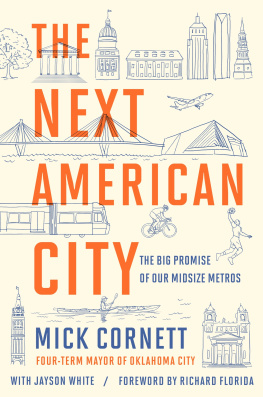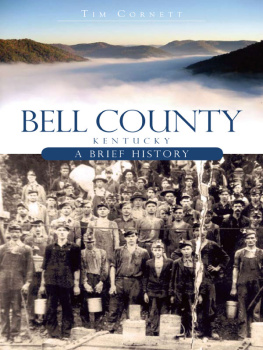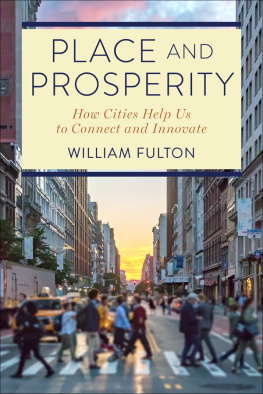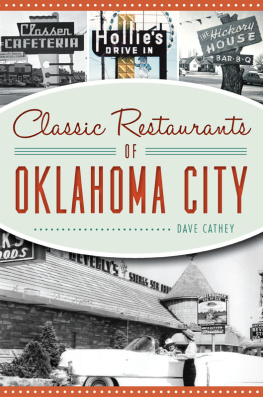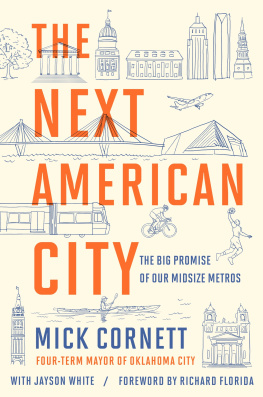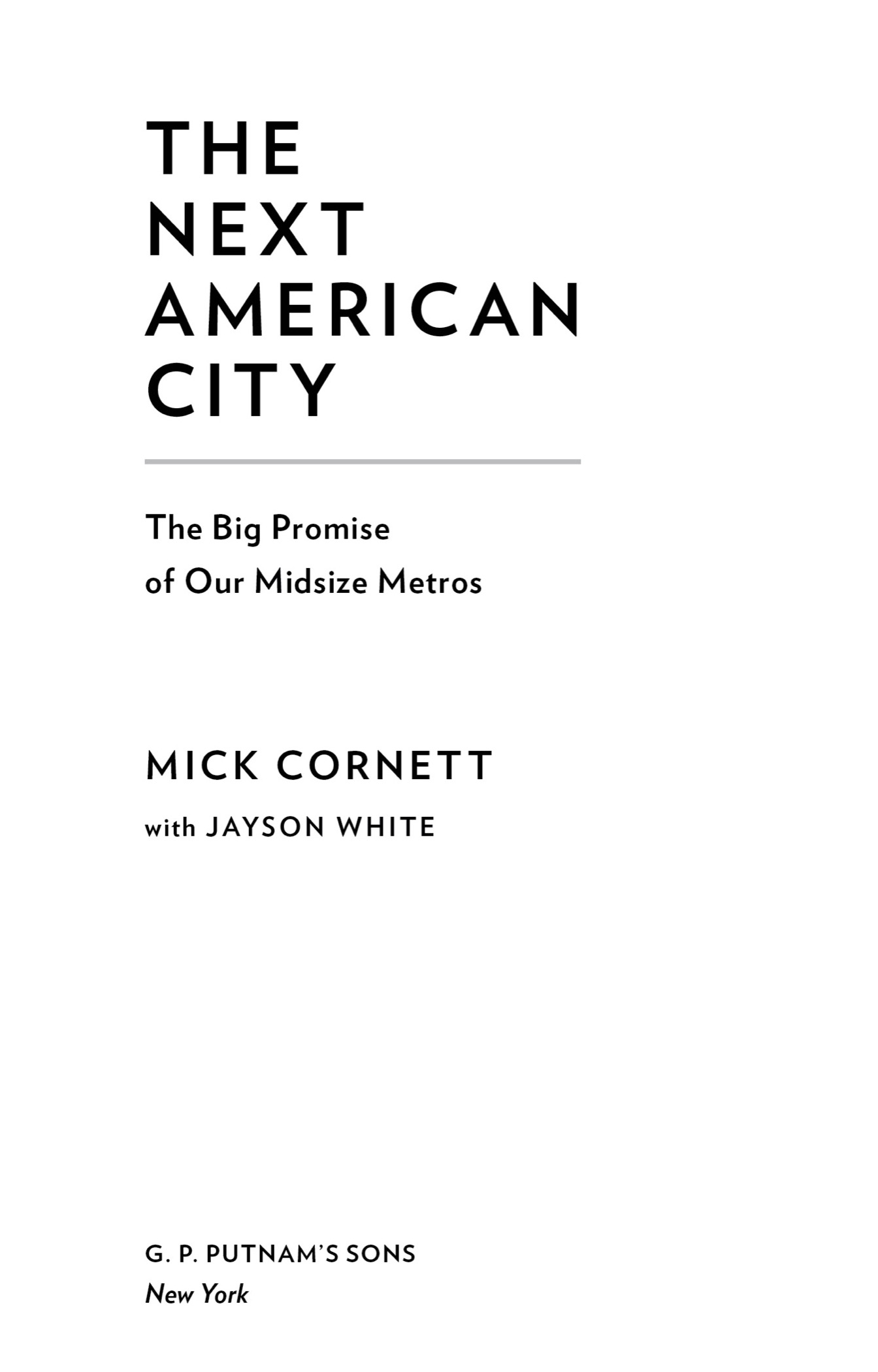G. P. PUTNAMS SONS
Penguin supports copyright. Copyright fuels creativity, encourages diverse voices, promotes free speech, and creates a vibrant culture. Thank you for buying an authorized edition of this book and for complying with copyright laws by not reproducing, scanning, or distributing any part of it in any form without permission. You are supporting writers and allowing Penguin to continue to publish books for every reader.
Names: Cornett, Mick, author. | White, Jayson, author.
Title: The next American city: the big promise of our midsize metros / Mick Cornett with Jayson White.
Description: New York: G. P. Putnams Sons, 2018. | Identifiers: LCCN 2018022150 | ISBN 9780399575099 (hardback) | ISBN 9780399575105 (epub)
Subjects: LCSH: City planningUnited States. | Cities and townsGrowth. | Sociology, UrbanUnited States. | BISAC: SOCIAL SCIENCE / Sociology / Urban. | POLITICAL SCIENCE / Public Policy / City Planning & Urban Development. | HISTORY / United States / General.
p. cm.
To Carroll and Nona Cornett, who taught their youngest child to work hard, dream big, and give back
Foreword
A funny thing happened in the early years of the millennium. A rising global economy, alongside powerful new technologies that connected corners of the globe in an instant, would make it possible for us to live and work virtually anywhere we wanted. It seemed all but certain that the forces that were connecting our world would flatten it, too, and continue to push people apart.
Well, those forces did the opposite. They drove us closer together, not farther apart. They brought us back to cities and to urban life.
The twentieth century was the century of suburbanization: the flight from cities of people and industry, commerce and jobs as far from downtowns as our cars and highways could take us. The American Dream was then a vision of a big house and a car followed by a bigger house, two cars, and more. A big plot of land you could call your own. It was life on Americas next great frontier, what the urban historian Kenneth Jackson called the crabgrass frontier. As a young boy growing up in New Jersey, I watched my hometown of Newark decline. I saw the city erupt into riots; I saw the factory where my father worked shutter; I saw the newspaper where my mom worked, The Star-Ledger, ringed with barbed-wire fences. Between 1950 and 1980, Boston lost almost 30 percent of its population. After the Boeing Bust, Seattles unemployment reached as high as 25 percent. In 1975, New York Citywhile still arguably the worlds most powerful global center of business and corporate financenearly declared bankruptcy. One of my professors at Rutgers wrote an article provocatively titled The City as Sandbox, which argued that Americas cities had become hollowed-out shells, having lost their core economic functions to the suburbs.
But now, shockingly, the twenty-first century has been deemed the century of the city. Young people, professionals, and a growing predominance of scientists, techies, knowledge workers, and artists, designers, and media typesa group I named the creative classhave streamed back to cities in ways no one anticipated. Major companies are heading back to cities in droves. And even start-up companies are abandoning their tech-driven nerdistans in suburban office parks for the vibrancy and hubbub of urban centers.
So far, it is fairly clear that large cities and metropolitan areas have benefited disproportionately from this urban shift. The first two decades of this urban revival have been marked by winner-take-all urbanism wherein a relatively small number of superstar cities like New York and London and knowledge centers like San Francisco, Boston, and Seattle have attracted the largest concentrations of talent, ideas, investment, and economic activity.
However, the reality is that the new urban knowledge economy is not determined by size alone. In fact, population size and population growth are poor predictors of innovation and economic growth. And as our largest urban centers become increasingly expensive, unaffordable, and divided, they price out and drive away the very diversity that powered their innovativeness and growth to begin with. As the late great urbanist Jane Jacobs once told me, When a place gets boring, even the rich people leave.
Its a big mistake to write off small places. College towns in particular have boomed, as have a host of smaller and midsize cities, even rural areas. Size may be an advantage but it is not the sole determinant of success. Smaller places that cultivate innovation and creativity, have abundant natural or urban amenities, and connect to larger centers in the United States and the world are thriving.
The reality of our time is that the world is spikynot flat. While technology may have flattened access to ideas and information, the reality of our time is that access to opportunity has become increasingly spiky in this urban century. And this spikiness occurs across all scales. Some large placesthe ones we all know and talk aboutare doing fine, but others are struggling. And the same goes for small and medium-size cities and rural areas. Some thrive, others coast along, and many others decline.
After years of study, Ive concluded that the key thing that distinguishes the thriving places of any and all sizes is surprisingly simple. Successful places are intentional. They undertake efforts to leverage and build upon their own unique assets. They mobilize their anchor institutions, their own civic organizations, and their people. They build true public-private partnerships. And, large or small, they create a genuine quality of place that all can see and feel.
As I travel to places like Milwaukee and Des Moines and Boise and Oklahoma City, my former hometown of Pittsburgh, my wifes hometown of Detroit, and countless others across America, I see the incredible progress many so-called flyover places have made. And now I watch as even smaller communitieslike Bentonville or El Dorado, Arkansas (the latter chronicled in these very pages)do much the same to leverage their own knowledge assets or lakefronts and hillsides or arts communities to create their own renaissance. It can be done. It is being done. It does take money. And smart policy. And great local leaders. But above all, it takes intentional leadership to mobilize the energy of the community to do it.
In the decade or so since writing The Rise of the Creative Class, I watched Mick Cornett mobilize his community in just that way during his four terms as mayor of Oklahoma City. If youve heard of him at all, its likely from the time he famously energized his community by putting the entire town on a diet to encourage fitness and vitalitylong before wellness became a watchword of the new urbanism. His accomplishments go far beyond that single story, however. Cornett was the longest serving in a long line of fiscally conservative Oklahoma City mayors that have understood the importance of a city investing in itself in this new urban, talent-driven age. While maintaining his focus on balanced budgets and sound economic policy, this Republican leader understood when, and how, local taxes could effectively and uniquely fund local infrastructure and improve the quality of place and quality for his community.

